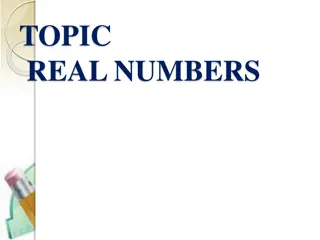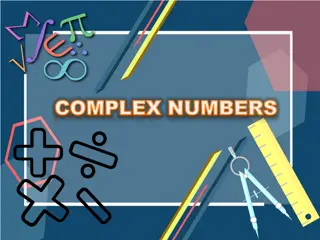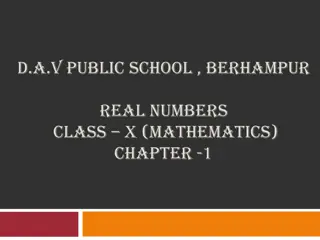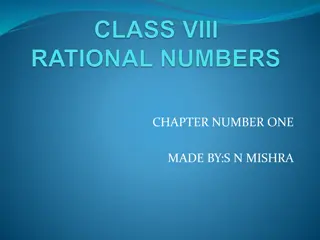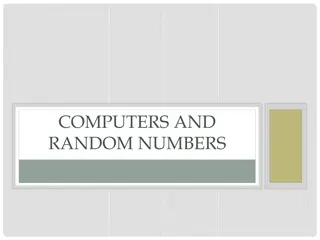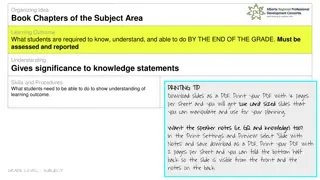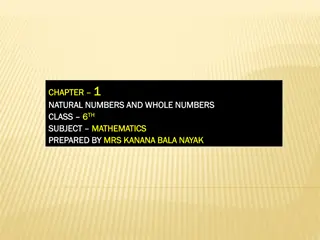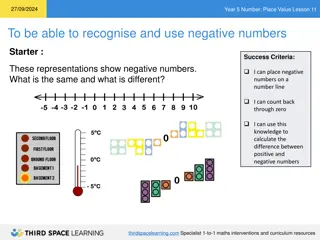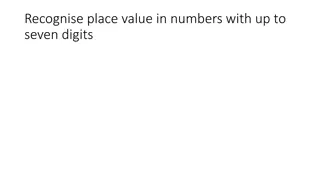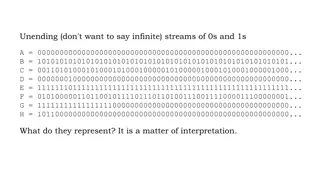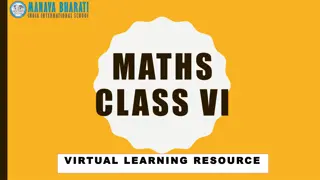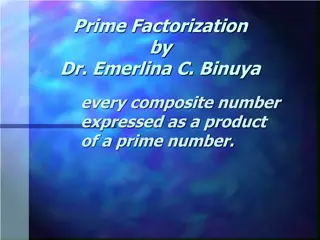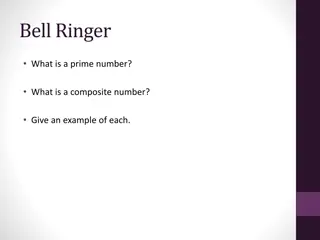
Understanding Place Value and Partitioning Numbers up to 1,000,000
Explore the concept of place value and learn how to partition numbers up to 1,000,000 using a part-whole model. Discover the importance of digit positioning and explore Gattegno charts to identify patterns within numbers. Follow along with examples to deepen your understanding of number structure.
Download Presentation

Please find below an Image/Link to download the presentation.
The content on the website is provided AS IS for your information and personal use only. It may not be sold, licensed, or shared on other websites without obtaining consent from the author. If you encounter any issues during the download, it is possible that the publisher has removed the file from their server.
You are allowed to download the files provided on this website for personal or commercial use, subject to the condition that they are used lawfully. All files are the property of their respective owners.
The content on the website is provided AS IS for your information and personal use only. It may not be sold, licensed, or shared on other websites without obtaining consent from the author.
E N D
Presentation Transcript
Y6 MATHS Numbers to 1,000,000
Numbers to 1,000,000 Key Information Place value is the value of a digit based on its position in a number. A place value chart is used to identify the value of the digits that make up a number. The chart is broken up into columns which represent ones , tens , hundreds , thousands , ten thousands , and so on. It can also represent decimal numbers such as tenths , hundredths , thousandths , and so on. A Gattegno chart is a type of place value chart designed to recognise the patterns in the way that we count and our number structure. Partitioning is when a number is split into different parts, usually into hundreds, tens and ones. For example, the number 547 can be partitioned into 500, 40 and 7.
Numbers to 1,000,000 Let s start with a question about partitioning numbers to 1,000,000, which is linked to the new learning later in this lesson.
Numbers to 1,000,000 We can use a part-whole model to partition numbers to show the value of each digit. For example: 9,999 Remember Start with the digit in the ones column and use zeros as place holders for digits in the other columns. 9,000 9 900 90 We can write this as 9,999 = 9,000 + 900 + 90 + 9
Numbers to 1,000,000 Remember Use the part-whole model to partition 13,256. Start with the digit in the ones column and use zeros as place holders for digits in the other columns. 13,256 We can write this as 13,256 =
Numbers to 1,000,000 Remember Use the part-whole model to partition 13,256. Start with the digit in the ones column and use zeros as place holders for digits in the other columns. 13,256 10,000 6 3,000 200 50 We can write this as 13,256 = 10,000 + 3,000 + 200 + 50 +6
Numbers to 1,000,000 Now that we are ready to move on, we can learn about numbers to 1,000,000.
Numbers to 1,000,000 Look at the Gattegno chart and discuss any patterns you can see. 1,000,000 100,000 10,000 1,000 200,000 20,000 2,000 300,000 400,000 500,000 600,000 30,000 40,000 3,000 4,000 300 400 30 40 3 4 700,000 800,000 900,000 70,000 80,000 7,000 8,000 700 70 7 50,000 5,000 500 60,000 6,000 600 90,000 9,000 900 100 10 200 20 800 80 50 60 6 90 1 2 5 8 9 What happens as you move between the rows? Follow up question 20,000 is how many times greater than 200? What happens as you move between the columns?
Numbers to 1,000,000 Look at the Gattegno chart and discuss any patterns you can see. 1,000,000 100,000 10,000 1,000 200,000 20,000 2,000 300,000 400,000 500,000 600,000 30,000 40,000 3,000 4,000 300 400 30 40 3 4 700,000 800,000 900,000 70,000 80,000 7,000 8,000 700 70 7 50,000 5,000 500 60,000 6,000 600 90,000 9,000 900 100 10 200 20 800 80 50 60 6 90 1 2 5 8 9 What happens as you move between the rows? Numbers multiply or divide by 10. What happens as you move between the columns? Numbers change by 1 according to their place value. Follow up question 20,000 is how many times greater than 200? 100
Numbers to 1,000,000 Use the Gattegno chart to find the numbers you would use to make 56,357. 1,000,000 100,000 10,000 1,000 200,000 20,000 2,000 300,000 400,000 500,000 600,000 30,000 40,000 3,000 4,000 300 400 30 40 3 4 700,000 800,000 900,000 70,000 80,000 7,000 8,000 700 70 7 50,000 5,000 500 60,000 6,000 600 90,000 9,000 900 100 10 200 20 800 80 50 60 6 90 1 2 5 8 9 Follow up question We can write this as 56,357 = How do you know where to put the commas?
Numbers to 1,000,000 Use the Gattegno chart to find the numbers you would use to make 56,357. 1,000,000 100,000 10,000 1,000 200,000 20,000 2,000 300,000 400,000 500,000 600,000 30,000 40,000 3,000 4,000 300 400 30 40 3 4 700,000 800,000 900,000 70,000 80,000 7,000 8,000 700 70 7 50,000 5,000 500 60,000 6,000 600 90,000 9,000 900 100 10 200 20 800 80 50 60 6 90 1 2 5 8 9 Follow up question We can write this as 56,357 = 50,000 + 6,000 + 300 + 50 + 7 How do you know where to put the commas? Digits are in groups of 3, separated by a comma.
Numbers to 1,000,000 Use the Gattegno chart to find the numbers you would use to make 1,000,000 100,000 10,000 1,000 200,000 20,000 2,000 300,000 400,000 500,000 600,000 30,000 40,000 3,000 4,000 300 400 30 40 3 4 700,000 800,000 900,000 70,000 80,000 7,000 8,000 700 70 7 50,000 5,000 500 60,000 6,000 600 90,000 9,000 900 100 10 200 20 800 80 50 60 6 90 1 2 5 8 9 Note We can write this as = Use this slide to practise partitioning and making numbers to 1,000,000.
Numbers to 1,000,000 We can also use place value charts to see the value of each digit in a number. What number is being represented on the chart below? M HTh TTh Th H T O
Numbers to 1,000,000 We can also use place value charts to see the value of each digit in a number. What number is being represented on the chart below? M HTh TTh Th H T O 2 4 3 5 9 1 243,591 = 200,000 + 40,000 + 3,000 + 500 + 90 + 1
Numbers to 1,000,000 Use the place value chart to partition 678,251. M HTh TTh Th H T O
Numbers to 1,000,000 Use the place value chart to partition 678,251. M HTh TTh Th H T O 6 7 8 2 5 1 678,251 = 600,000 + 70,000 + 8,000 + 200 + 50 + 1 This is called standard partitioning.
Numbers to 1,000,000 Let s look at different ways of partitioning 678,251. 678,251 = 600,000 + 70,000 + 8,000 + 200 + 50 + 1 We can partition the number in different combinations, for example: 678,251 = 600,000 + 70,000 + 8,000 + 200 + 51 678,251 = 600,000 + 78,000 + 200 + 50 + 1 This is called non-standard partitioning and is sometimes used when calculating.
Numbers to 1,000,000 Now that we understand numbers to 1,000,000, let s apply our learning to some problem solving and reasoning questions.
Numbers to 1,000,000 Two children have partitioned the number 287,543. Who do you agree with and why? I have 200,000 + 80,000 + 7,000 + 500 + 40 + 3. I have 280,000 + 7,000 + 500 + 43. Lucas Star I agree with because
Numbers to 1,000,000 Two children have partitioned the number 287,543. Who do you agree with and why? I have 200,000 + 80,000 + 7,000 + 500 + 40 + 3. I have 280,000 + 7,000 + 500 + 43. Lucas Star I agree with both because they have both partitioned the number correctly, but Nathan has used non-standard partitioning and Maisy has used standard partitioning.
Numbers to 1,000,000 I have chosen a number that can be partitioned using the section of Gattegno chart below. Use the clues to find my number. 300,000 400,000 500,000 30,000 40,000 3,000 4,000 300 30 3 My number has 6 digits. 5 of the digits are odd. My number is even. Each digit is different to the next digit. My number does not include a zero. 50,000 5,000 500 400 40 50 4 5
Numbers to 1,000,000 I have chosen a number that can be partitioned using the section of Gattegno chart below. Use the clues to find my number. 300,000 400,000 500,000 30,000 40,000 3,000 4,000 300 30 3 My number has 6 digits. 5 of the digits are odd. My number is even. Each digit is different to the next digit. My number does not include a zero. 50,000 5,000 500 400 40 50 4 5 The number could be either 535,354 or 353,534.

